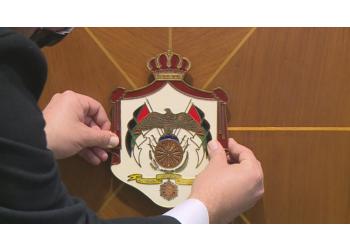Shi’ite pilgrims travelling to Jordan … an old story gets a new lease of life

Some people may think that the story of Jordan’s refusal to welcome Shi’ite pilgrims and in particular, Iranian pilgrims, is a new one and has resulted from the critical, political changes in the region in recent years. They may link it specially to developments in the current conversation about Hashemite custodianship of holy relics in Jerusalem and the Deal of the Century (Trump’s peace plan) and other issues that directly impact on Jordan and its political and social ranking.
Since the beginning of this century, Iranian attempts have persisted in an attempt to persuade the various Jordanian governments and decision makers to reach an agreement that would allow Iranian pilgrims, specifically, and Shi’ite pilgrims, more broadly, to visit shrines of the Prophet’s Companions in the Kingdom. The shrine that is most closely tied to the Shi’ite conscience and doctrine is the shrine of the Companion Jafar Al-Tayaar, found in the Mazar village, in the province of Kerak in southern Jordan.
In 2001, the Jordanian Ambassador to Iran, Dr Bassam Al-Aamosh, formerly the leader of the Muslim Brotherhood Organisation, warned of Iranian security breaches in Jordan. He declared that on many occasions he had refused Iranian generous offers that he received as a representative of his country during diplomatic work, offered in return for leniency on the subject of ‘Shi’ite pilgrimage to the shrines’.
In a parliamentary session in 2005, the voice of the former Deputy Leader Nariman Al-Rusman rose up under the dome of the Jordanian Parliament, as she called on the government in power at the time to launch an enquiry into rumours of permission to build Hussainiya, supposedly granted to a resident carrying Iraqi citizenship in Abdoun, one of the elite neighbourhoods in West Amman.
This was followed by many stories about Hizbullah’s Iranian arms, exposed by the Jordanian security services and this pushed Hassan Nasrallah to declare that the weapons were intended for Palestine and not for within Jordan itself. It would appear that His Grace ignored the fact that the border of southern Lebanon is closer to Palestine than taking the unjustified detour through Jordan! In addition, Jordanian intelligence announced at the time that they had uncovered a sleeper cell operating in the interests of Iran, and there was also an incident where citizens in Kerak set a house ablaze saying that it was being used by the Shi'ite, Jordanian organisation for Hussainiya. Many Jordanian Shi'ites now hesitate before revealing their religious identity, out of fear that they would be subjected to harassment. The Shi'ite population in Jordan numbers just under 5000, the majority of whom live in the North.
These experiences confirmed former fears voiced by King Abdullah II in 2004, warning of what he called the Shi'ite crescent and the danger it posed to the region. Yet if Jordanian interests are to placed above any other considerations, it would seem that this danger belongs to the forgotten past, even it that means opening the door to religious tourists, of whom the most significant group would be those visiting the Shi'ite shrines (the tourists are referred to in this way as Iranian Shi'ites are but a small percentage of Shi'ites worldwide and include many Arabs too).
“I want to say to all who reject the idea of welcoming of Shi'ites to Jordan that the Jews spent years coming and going in this country and I didn’t hear that Jordanians were converting to Judaism”. This is the answer of one of the residents of Kerak, who did not deny his political fear on the subject but sees that there are huge, economic benefits that the people in the south and Jordanians generally would reap from working in the services and tourism industry - an industry that has completely ceased to exist since the pandemic started. For the pilgrim is a visitor at the end of the day, who buys and sells and pays for medical care and lots of commercial privileges and services that in turn will reinvigorate an economy that is currently deteriorating.
The first official Jordanian visit of a Jordanian parliamentary delegation after the Iran-Iraq war in the 1980s took place in 2013, headed by the then leader of the Jordanian Chamber of Deputies, Atef Tarawneh, and a large number of the representatives and journalists attended the international, Islamic parliamentary conference. On this day, Iranian representatives once more presented their gracious, previous offer, yet this time adding irresistible conditions concerning the shrines: the Iranian government would pledge to develop all of the infrastructure of the shrines and build tourist facilities, markets and museums at the shrines; a commitment that a number of the pilgrims would be set out by Jordan and the places in which they are permitted to stay and circulate; that security services would be provided with a pre-approved list of pilgrims and acceptance that Jordan can welcome and refuse visitors at their will; and even the offer of building an airport in the south to ensure that pilgrims will not move in the rest of the provinces if necessary. Yet once more this offer was refused.
The statements of the Iranian Ambassador to Jordan in April 2017 did not help to improve the state of negotiations between the two nations. The Jordanian Foreign Office informed the Ambassador, Mojaba Ferdowsipour, of the strong objections following his criticism of King Abdullah II, as stated in an interview with the Washington Post newspaper. In this interview, the Ambassador criticised the King’s comment on the presence of the Iranian Revolutionary Guard at the Kingdom’s borders in the north, stretching roughly seventy kilometres along the border between Syria and Jordan, which he described as ‘not good news for us’.
The Jordanian public is split: on the one hand, there is rejection and fear of ‘the negative Sufi, Shi'ite tide with regards to the former experience of other neighbouring Arab countries’ and on the other, those who support backing Jordanian interests specifically and not waiting for other Arab countries to compensate Jordan for its support as in the past. In spite of this, a question emerges regarding the possibility that what was once not good, may be good now, especially if we consider the hypothesis that takes into account that there may be more than one season of pilgrimage for a few thousand Shi’ite Muslims. Also, this may be opportunity for King Abdullah II to gain custodianship of the holy Shi’ite shrines as at the end of the day, the King is a descendent of the Prophet and the head of Alulbayt. From this perspective, perhaps many Shi’ites - especially Arabs - would not oppose the idea of the King as custodian of their holy relics and shrines.












































